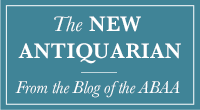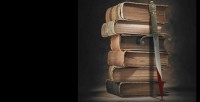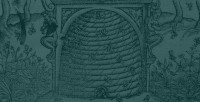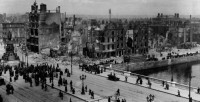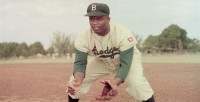These items are still missing as of 6/14/2019. The following books have gone missing from a locked display case at the Cortez Street Emporium, in Prescott, Arizona, sometime between May 9th and May 25th: MacDonald, Ross (Kenneth Millar). The Blue Hammer (Author's Proof Copy, Annotated). New York; Alfred A. Knopf, 1976. First edition, octavo; an uncorrected proof copy in yellow printed wrappers. The author's own copy with more than 60 holograph corrections to the text, in pencil. Page references for all of these corrections are given in pencil on the front wrapper, by MacDonald. Laid in are two pages of typed corrections to the text, signed "B" with quirky little remarks to MacDonald, prepared by fellow mystery writer William Campbell Gault, who is the dedicatee of the book and here a proof reader. A fine copy housed in a custom leather-backed clamshell box. Faulkner, William. Idyll in the Desert. New York; Random House, 1931. First edition, number 388 of 400 signed by the author; red marbled boards, with paper label on front board. Near fine, lacking the glassine dust jacket. Please contact the ABAA if offered. [more Missing from Prescott, Arizona]
The fourth installment of Kaitlin Manning's series on taking better pictures of rare books and ephemera. No matter what kind of camera you use, there are a few basic practices you can apply before you start shooting to improve the look and quality of your images (and to avoid fixing time consuming mistakes later on). While it is true that editing programs like Lightroom, Photoshop, and Gimp can work wonders and correct a myriad of errors, you will want to spend as little time as possible in these programs, especially if you are dealing with hundreds of photos at a time. Starting with good quality images from the beginning will eliminate the need for major edits -- and this begins before you even click the shutter. Make sure you have enough light. I've covered the basics of putting together a home studio in a previous post, but let me reiterate the need for good, diffuse light now. If your photos continuously look dull or underexposed, consider adding more light to the scene, but always make sure that it is properly diffused (i.e. there needs to be something translucent between the light and the object). Bare bulbs look harsh, create shadows, increase glare, and can either wash out or obscure details. Invest in a tripod. This was also mentioned briefly in a previous post, but let me elaborate a bit here: if you don't have the steadiest of hands and/or you routinely shoot manually in low speeds (generally less than 1/60 of a second) a tripod is a must. Camera shake can make you... [more The Savvy Bookseller: Tips and tricks before you shoot]
Friday, May 20th will see the premiere of my new opera with composer Stella Sung, a “rare book” opera, if you will, called The Book Collector, in which two men vie for possession of an exceedingly rare book. Why a rare book opera, you may ask? In truth, the opera is driven by the forces that have defined opera since its earliest days: jealousy and love, vengeance and mercy, the clash of social classes, free will bound by fate, and tragic, sometimes deadly misunderstandings. The auction floor, the bookseller's shop, the private library, and the book itself really serve as settings and props for the larger human ambitions that animate the characters. The “rare book” aspect of the opera was Stella's. She's long been fascinated by my day job at Bauman Rare Books. In fact, the first time we met in person was at the Florida Antiquarian Book Fair, the Florida Antiquarian Booksellers' Association's show held in St. Petersburg's Historic Coliseum (my friend Dana Gioia, former chair of the National Endowment for the Arts, first introduced the two of us as collaborative partners, but our work up to that point was done long-distance). Before we began work on The Book Collector, I had already worked with Stella as a librettist but, as the Dayton Daily News explains, my background situated me ideally—as both librettist and rare book dealer, perhaps a unique combination—“to fashion a plausible scenario for this particular opera.” Having worked at Bauman Rare Books for nearly... [more An Opera for Antiquarians]
Longtime Bay-area member Barney Rosenthal recently turned 94! (He was still buying and selling books up until very recently, too.) Here's the lovely card signed by his colleagues. Happy birthday, Barney! [more Barney Rosenthal Turns 94]
Michael Hackenberg, on behalf of the the Northern California Chapter of the Antiquarian Booksellers' Association of America is pleased to announce that the winner of the 2016 Kane Memorial Scholarship is Kyna Mallery of Back of Beyond Books in Moab, Utah. She will be using the $1500 scholarship to attend this summer's Colorado Antiquarian Book Seminar. Our congratulations to her! [more Kyna Mallery winner of 2016 Kane Memorial Scholarship]
This item is still missing as of 6/13/2019. Missing in transit to Spain: WERNER, Abraham Gottlob. Von den Ausserlichen Kennzeichen der Fossilien. Leipzig: Siegfried Lebrecht, 1774. 8vo. With 8 folding plates. Contemporary half-calf over boards. Please contact Howard Rootenberg at blroot@rootenbergbooks.com if offered. [more Missing in transit to Spain: Von den Ausserlichen Kennzeichen der Fossilie]
Job Posting: Historical Documents Dealer in Westport, CT Seeks Researcher with 3+ Years’ Experience
By Susan BennePrivate company in Westport, Connecticut seeks a researcher with exceptional organizational skills for small, friendly, fast-paced office that specializes in historical documents, books, and artifacts. Auction expertise a plus. Must be able to work quickly and accurately in cooperation with other staff members in a variety of roles. Excellent written and verbal communication skills a must. Responsibilities include research of new acquisitions for database and website, coordination of in-house auctions, representation at prestigious shows and exhibitions. Proficiency in computer databases, internet, and social media skills are necessary. Bachelor's degree plus three years' experience. Salary range: $40,000-$60,000 yearly. Please send resume to: Loraine@universityarchives.com. [more Job Posting: Historical Documents Dealer in Westport, CT Seeks Researcher with 3+ Years’ Experience]
ABAA-members George Koppelman and Daniel Wechsler were featured on CBS Sunday Morning this past weekend. The booksellers belief is that they may have identified Shakespeare's personal copy of John Baret's Alvearie; or Quadruple Dictionarie, and they have published a book detailing their exhaustive investigation. We previously wrote about Koppelman and Wechsler's ground-breaking work in 2014... [more CBS News: Shakespeare’s Beehive]
The streets of Dublin witnessed the largest parade in Irish history this Easter, as hundreds of thousands gathered to mark the centenary of the 1916 Easter Rising. That revolt, by historical standards, was brief and seemingly futile in the short term. After the April 24 proclamation of an Irish Republic, perhaps fewer than 2,000 participants actually took up arms, and they were easily crushed within days by the British bombardment of much of central Dublin and the surrender and execution of its leaders. Nevertheless, the Rising boasts an outsize legacy not only in its ultimate political consequence of Irish independence five years later, but in its literary birthright, for a number of those involved in the uprising were authors of poetry and prose that had sculpted perceptions of Irish nationhood. Moreover, the destruction wrought upon Dublin and the execution of the rebel leadership inspired others who had not been involved – even some who had looked upon the armed uprising in dismay – to grapple with its legacy in words that resound to this day. The struggle for Irish independence from the British Crown had surged and ebbed for many years, of course, one of the high points being the months of battles led by the United Irishmen in 1798, inspired by the successful revolutions in the American colonies and in France. By the 1910s, however, many had thought that the flame of discontent had shrunken to a dull gleam. Although the House of Lords had failed to pass a Home Rule B... [more 1916: Collecting Ireland’s Easter Rising]
Hailed as "the sports equivalent of the Emancipation Proclamation," one of the original contracts Jackie Robinson signed with the Brooklyn Dodgers has been authenticated by ABAA member John Reznikoff (University Archives) and appraised at $36 million by ABAA member Seth Kaller (Seth Kaller, Inc.). Owned by businessman Mykalai Kontilai, the contracts will go on display at the Collectors Café in New York City next week. ESPN reported on the contact this week, quoting Reznikoff: "It passed all the tests with flying colors, everything that I looked at," Reznikoff said this week. "There's a lot of components to a document. There's ink, paper, printing, and everything was consistent." "I'm 110 percent sure" it's real, Reznikoff said. and Kaller: "Their effect on American history, and even the world, transcends the bounds of sports," Kaller wrote in his appraisal. "Jackie Robinson's contracts are documents of freedom in the same vein as the Declaration of Independence, the Constitution and the Emancipation Proclamation." You can read the ESPN story in its entirety here... Some items signed by Jackie Robinson from abaa.org: Fine signed and inscribed 3.5" X 5.5" postcard portrait by Jackie Robinson in the dugout. He signed in blue ball point pen, "To...with best wishes, Jackie Robinson." The last two letters are light. His printed signature shows below the portrait. (Offered by Schulson Autographs) WAIT TILL NEXT YEAR. THE LIFE STORY OF JACKIE ROBINSON (Signed, First Edition) New Yor... [more Jackie Robinson’s Original Contracts Authenticated]

